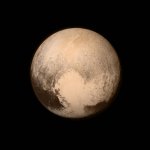GodsEmbryo
Closed Account
NASA’s New Horizons Spacecraft Nears Historic July 14 Encounter with Pluto
The fastest spacecraft ever launched, New Horizons has traveled a longer time and farther away – more than nine years and three billion miles – than any space mission in history to reach its primary target. Its flyby of Pluto and its system of at least five moons on July 14 will complete the initial reconnaissance of the classical solar system. This mission also opens the door to an entirely new “third” zone of mysterious small planets and planetary building blocks in the Kuiper Belt, a large area with numerous objects beyond Neptune’s orbit.
The flyby caps a five-decade-long era of reconnaissance that began with Venus and Mars in the early 1960s, and continued through first looks at Mercury, Jupiter and Saturn in the 1970s and Uranus and Neptune in the 1980s.
Reaching this third zone of our solar system – beyond the inner, rocky planets and outer gas giants – has been a space science priority for years. In the early 2000s the National Academy of Sciences ranked the exploration of the Kuiper Belt – and particularly Pluto and its largest moon, Charon – as its top priority planetary mission for the coming decade.
New Horizons – a compact, lightweight, powerfully equipped probe packing the most advanced suite of cameras and spectrometers ever sent on a first reconnaissance mission – is NASA’s answer to that call.
The spacecraft’s suite of seven science instruments – which includes cameras, spectrometers, and plasma and dust detectors – will map the geology of Pluto and Charon and map their surface compositions and temperatures; examine Pluto’s atmosphere, and search for an atmosphere around Charon; study Pluto’s smaller satellites; and look for rings and additional satellites around Pluto.
Teams operating the spacecraft [...] skillfully navigate New Horizons toward a precise target point 7,750 miles (12,500 kilometers) from Pluto’s surface. That targeting is critical, since the computer commands that will orient the spacecraft and point its science instruments are based on knowing the exact time and location that New Horizons passes Pluto.
“Our team has worked hard to get to this point, and we know we have just one shot to make this work,” said Alice Bowman, New Horizons mission operations manager at the Johns Hopkins University Applied Physics Laboratory (APL) in Laurel, Maryland, which built and operates the spacecraft. “We’ve plotted out each step of the Pluto encounter, practiced it over and over, and we’re excited the ‘real deal’ is finally here.”
The spacecraft’s work doesn’t end with the July flyby. Because it gets one shot at its target, New Horizons is designed to gather as much data as it can, as quickly as it can, taking about 100 times as much data on close approach as it can send home before flying away. And although the spacecraft will send select, high-priority datasets home in the days just before and after close approach, the mission will continue returning the data stored in onboard memory for a full 16 months.
Source: (shortened version from) NASA article
Image from July 9th

I've been following this for a while now and I'm pretty excited by this! Getting close... !


